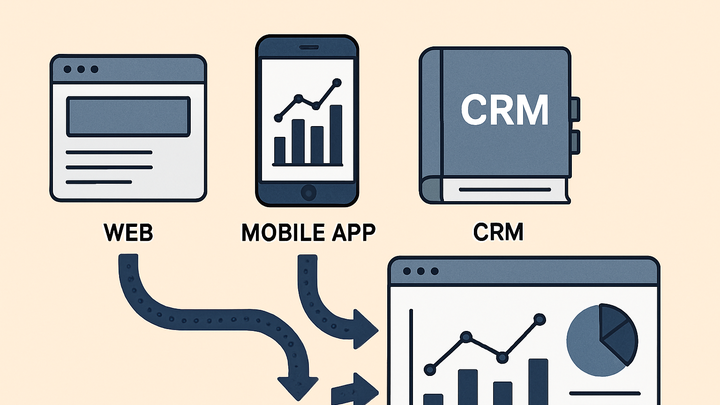Published on 2025-06-26T04:37:11Z
What is Cross-Platform Data? Examples and Implementation
Cross-platform data refers to the practice of collecting, unifying, and analyzing user interactions across multiple digital touchpoints, such as websites, mobile apps, and other channels. By bringing these disparate data streams together, organizations can gain a holistic view of the customer journey, enabling more accurate attribution, personalized experiences, and strategic decision-making.
Implementing cross-platform analytics involves establishing consistent data collection methods across each platform, resolving user identities to stitch sessions together, and centralizing the combined data into a unified repository for reporting and analysis. Modern analytics solutions like Google Analytics 4 (GA4) support native cross-platform tracking, while tools like PlainSignal offer lightweight, cookie-free analytics for websites. Despite the benefits, teams must navigate challenges around data privacy, identity resolution, and maintaining data quality to ensure reliable insights.
In practice, businesses rely on well-defined data strategies and robust technical implementations to leverage cross-platform data effectively. This includes configuring data streams, setting up user ID tracking, and adhering to governance policies. Understanding the nuances of cross-platform integration is essential for any organization looking to optimize marketing performance and enhance user experiences in a multi-channel world.
Cross-platform data
Unified user and event data from multiple digital platforms, enabling holistic analytics and accurate attribution across web, mobile, and more.
Why Cross-Platform Data Matters
Cross-platform data enables businesses to understand how users interact with their brand across different channels—websites, mobile apps, and other touchpoints. By unifying these data streams, organizations can obtain a complete picture of the customer journey, improve attribution accuracy, and drive more informed decision-making.
-
Holistic view of customer journeys
Combining data from all platforms reveals end-to-end user pathways, highlighting touchpoints that influence conversions and retention.
-
Accurate attribution
Unified data prevents over- or under-counting conversions by attributing user actions to the correct channel and sequence of interactions.
Core Components of Cross-Platform Data
Building effective cross-platform analytics requires interoperable components for collecting, identifying, and centralizing data from multiple sources. Each component plays a critical role in ensuring data consistency and reliability.
-
Data collection across channels
Implement consistent tagging and event tracking on websites, mobile apps, and other digital properties to capture user actions uniformly.
-
User identity resolution
Stitch sessions together by assigning persistent user identifiers (IDs) that follow individuals across devices and platforms.
-
Data centralization and warehousing
Aggregate collected data into a central repository—such as a data warehouse or analytics platform—for unified querying and reporting.
Implementing Cross-Platform Tracking
Cross-platform tracking can be implemented using modern analytics platforms and lightweight tools. Below are examples using Google Analytics 4 and PlainSignal.
-
Google analytics 4 setup
GA4 natively supports web and app data streams. Configure separate streams and link them under the same GA4 property to unify reporting.
-
Gtag.js integration
Place the gtag.js snippet on all web pages and configure your Firebase SDK for mobile app events.
-
Data streams configuration
In GA4, create web and iOS/Android streams under a single property to aggregate metrics across platforms.
-
-
Cookie-free tracking with PlainSignal
PlainSignal offers simple, privacy-friendly analytics without cookies or personal data collection. Add the following snippet to your HTML:
-
Example PlainSignal snippet
<link rel="preconnect" href="//eu.plainsignal.com/" crossorigin /> <script defer data-do="yourwebsitedomain.com" data-id="0GQV1xmtzQQ" data-api="//eu.plainsignal.com" src="//cdn.plainsignal.com/plainsignal-min.js"></script>
-
Best Practices and Common Pitfalls
To maximize the value of cross-platform data, adhere to best practices around user identification, privacy compliance, and data quality. Avoid common mistakes that can lead to fragmented or inaccurate reporting.
-
Ensure consistent user ids
Use a centralized identity strategy—such as customer login IDs—so the same identifier is recognized across all platforms.
-
Handle data privacy and compliance
Implement consent management and comply with regulations like GDPR and CCPA when tracking users across platforms.
-
Monitor data quality
Regularly validate event schemas, fix tagging errors, and reconcile discrepancies between platforms to maintain reliable analytics.
